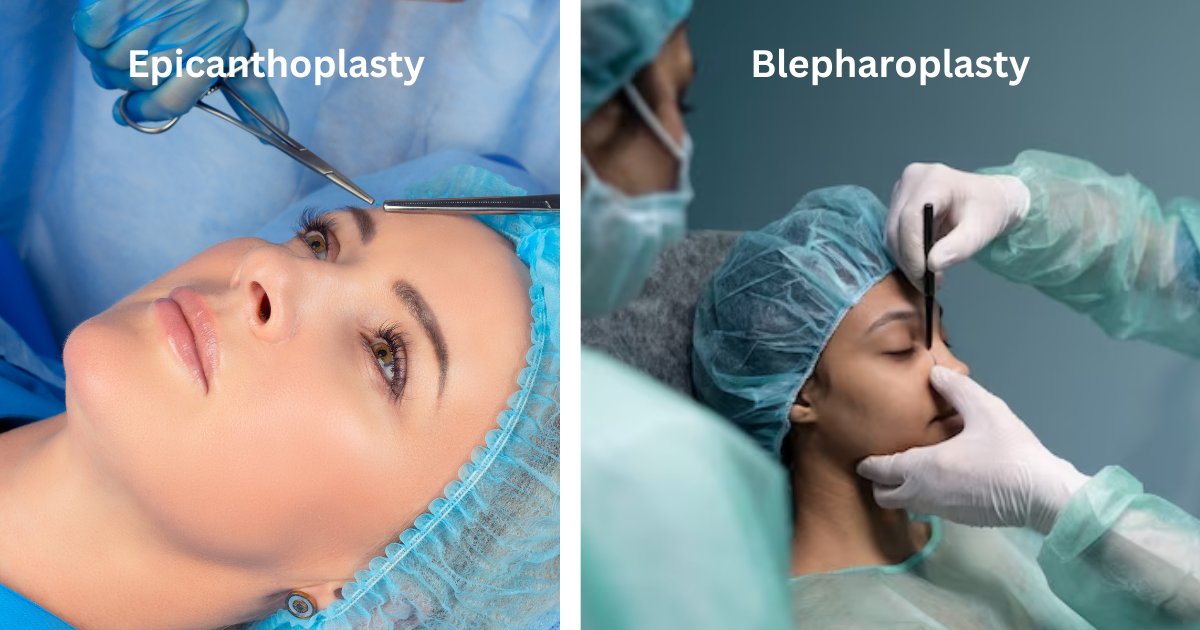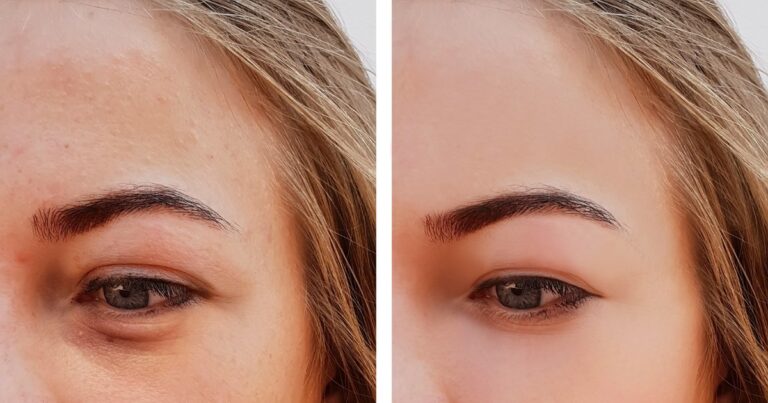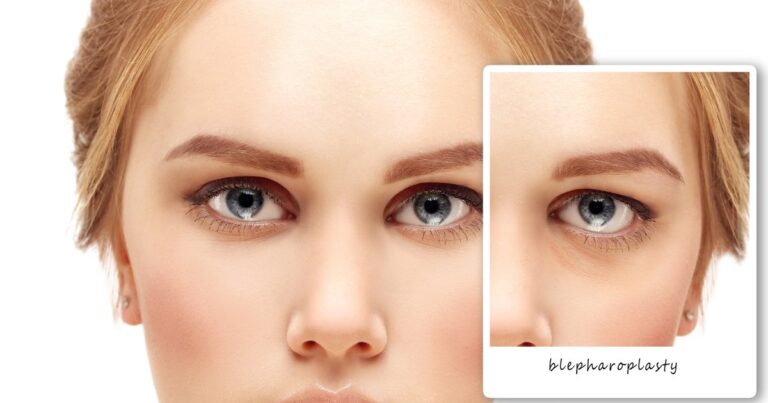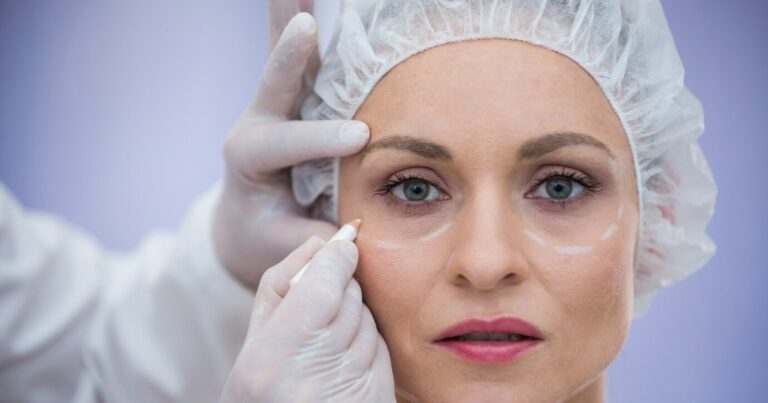Enhance your facial aesthetics with Epicanthoplasty and Blepharoplasty – specialised surgeries for eye rejuvenation and visual improvement.
Canthoplasty And Blepharoplasty
Epicanthoplasty and blepharoplasty are specialised surgical procedures in cosmetic surgery, focusing on the eyes. Epicanthoplasty alters the epicanthic fold to widen the eye’s inner corner, while blepharoplasty involves modifying the eyelids to enhance aesthetic appeal or improve vision. Together, these techniques can dramatically rejuvenate one’s facial appearance.
What is Epicanthoplasty Surgery?
Epicanthoplasty, also known as inner eye corner surgery, is a procedure that reshapes the inner corner of the upper eyelids near the nose. It creates a fold that makes the eyes appear larger and more open.
The surgery removes or repositions skin and muscle from the inner corners to reduce the amount of skin covering the eye’s inner edge. It can be performed alone or along with blepharoplasty.
Benefits of Epicanthoplasty
Some benefits of epicanthoplasty include:
Book A Consultation With Dr Tarek Bayazid
Top-rated Plastic Surgeon For Eyelid Surgery in Dubai
Installment Plan Available
- It opens up and brightens the eyes
- Creates better eyelid symmetry
- It makes one look more refreshed and youthful
- Boosts self-confidence
Ideal Candidates
Good candidates for epicanthoplasty are those who have:
- Excess skin covering the inner corner of the eyes
- Asymmetric or uneven appearance of eye shape
- Narrow-looking eyes or poor eyelid symmetry
The procedure works for both men and women of any ethnic background.
What is Blepharoplasty Surgery?
Blepharoplasty, also called eyelid surgery or an eyelid lift, removes excess skin, muscle, and fat deposits from the upper and lower eyelids.
It can address signs of ageing like under-eye bags, drooping lids, and fine lines or wrinkles. The surgery creates a more youthful, rejuvenated eye area with improved vision in some cases.
There are a few different blepharoplasty techniques:
- Traditional incisional blepharoplasty
- Transconjunctival blepharoplasty
- Laser blepharoplasty
Benefits of Blepharoplasty
Advantages of undergoing blepharoplasty include:
- The smoother, tighter, more youthful-looking eye area
- Less puffy or hooded upper eyelids
- Reduction of under-eye bags and dark circles
- Improved peripheral vision in some cases
- Boosted self-image and confidence
Who is a Good Candidate for Blepharoplasty?
Ideal blepharoplasty candidates have:
- Excess upper eyelid skin covering the eyelashes
- Puffy, baggy lower eyelids
- Under eye hollowness or dark circles
- Good overall health with no eye disorders
The procedure can help people of all ages who want to refresh their eye area appearance.
What to Expect from Epicanthoplasty and Blepharoplasty Procedures
The Initial Consultation
The first step is an in-depth medical evaluation and consultation. The surgeon examines the eye area and discusses desired improvements. They also review medical history and determine candidacy.
The Surgery
Both procedures are typically done under local anaesthesia with sedation as an outpatient surgery. The steps involved include:
For epicanthoplasty:
- Small incisions were made at the inner corners of the upper lids
- Excess skin and muscle removed or repositioned
- Incisions closed with tiny dissolvable sutures
For blepharoplasty:
- Incisions made in natural creases of the upper lids and below the lower lashes
- Excess fat trimmed or redistributed
- Muscle modified to address eyelid droop
- Incisions closed with fine sutures, tape, or skin glue
Surgery time is 1-3 hours for an epicanthoplasty and 1-4 hours for a blepharoplasty.
Recovery After Surgery
Recovery timelines and protocols are similar for canthoplasty and blepharoplasty procedures. Patients can expect some common side effects, restrictions, and self-care needs in the first two weeks after surgery before settling into the final healing and results phase.
| Epicanthoplasty | Blepharoplasty | |
| Timeframe | 1-2 weeks | 1-2 weeks |
| Common Side Effects | Temporary swelling, bruising, irritation | Temporary swelling, bruising, irritation |
| Pain Management | Over-the-counter medication | Over-the-counter medication |
| Doctor’s Orders | Use antibiotic eye drops or ointments | Use antibiotic eye drops or ointments |
| Lifestyle Changes | – Keep head elevated while sleeping – Avoid rubbing eyes – Don’t wear contacts initially | – Keep head elevated while sleeping – Avoid rubbing eyes – Don’t wear contacts initially |
| Return to Normal Activity | Within 7-14 days | Within 7-14 days |
| Exercise & Driving Restriction | ~2 weeks | ~2 weeks |
| See Final Results | At ~6 weeks | At ~6 weeks |
The table summarises key points about recovery timelines and care after canthoplasty and blepharoplasty surgeries. Let me know if you would like any changes to the table.
After Care After Surgery
Proper aftercare is vital during recovery from canthoplasty and blepharoplasty eye surgeries. By following doctor’s orders and avoiding certain activities initially, patients can ensure proper healing. Aftercare guidelines typically involve:
- Using cold compresses and head elevation to reduce swelling in the first 48 hours
- Cleaning incision sites gently with saline solution to prevent infection
- Applying prescribed antibiotic ointments inside lower eyelids daily
- Wearing dark, oversized sunglasses outside to protect from wind, sun
- Keeping physical activity light after the first week, avoiding straining or jarring motions
- Staying well-hydrated and eating a high-protein diet to aid in healing
- Attending all follow-up appointments so the surgeon can monitor recovery
- Avoiding makeup, facial creams, and chlorinated water around the eyes until given the green light
- Not resuming contact lens use until eyes have full mobility and comfort
- Taking any prescribed medications to manage discomfort, acetaminophen or ibuprofen
Following doctor’s orders carefully in the first two weeks helps lead to proper healing after eye rejuvenation procedures.








